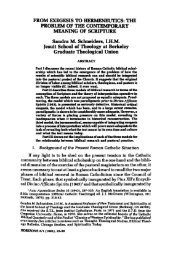WIFE AND SISTER THROUGH THE AGES - Blessed Edmund Rice ...
WIFE AND SISTER THROUGH THE AGES - Blessed Edmund Rice ...
WIFE AND SISTER THROUGH THE AGES - Blessed Edmund Rice ...
You also want an ePaper? Increase the reach of your titles
YUMPU automatically turns print PDFs into web optimized ePapers that Google loves.
126 SEMEIAtext and the unilluminated background of the narrative receives acharacteristic new illumination.Conventions also decline. Luther, for instance, hastened the decline ofallegorical interpretation. His opposition, never complete, was not onmethodological grounds, or because of the looseness of connection betweeninterpretation and text. His opposition was theological andpractical. Allegory had been used to interpret scripture non-christologically,for instance, in support of the monastic form of life. Such interpretationled scripture away from its true spiritual sense which alwaysconcerned Christ and thus constituted a danger that Luther countered byrestricting allegory (Bornkamm: 88-9). The conventions of allegoricalreading were subsequently largely lost within Christian tradition.Finally, the conventions of reading contribute to variability by thevery freedom that they allow to interpretation. Realistic reading providesa powerful warrant for the interpreter to fill in what is not explicit in thetext. The interpreter is to treat the narrative as if it depicted an actualevent and the interpreter is therefore warranted to incorporate what thetext does not say, but what the interpreter knows would have pertained tosuch an event. It is within that "what the interpreter knows" that much ofthe variation in interpretation arises. Modern conventions of realisticreading place greater control on what may be introduced into the depictionof the actual event. Yet anyone familiar with modern biblical criticismknows that such control is a very relative thing and interpretation continuesto vary within the space afforded by the realistic conventions. For itspart, allegorical interpretation had its own appropriate freedoms. Incertain situations, particularly polemical situations where a precise andagreed meaning of the text was crucial to the discussion, the freedom ofsuch conventions could be a drawback and more restrictive conventionswere necessary. But in many other circumstances the freedom in interpretingthe texts within common interpretive conventions was highlypositive, allowing Philo to mediate Jewish and Hellenistic culture, forinstance, or Luther to exhort faithfulness in the face of adversity.I am conscious that it may seem that I have missed the heart of thequestion of textual determinacy by focusing on the history of interpretationand then interpretive conventions. Conventions represent competenciesin the interpreter; they lie on the interpreter's side of the equation.Stressing the rule-governed nature of those competencies may make theinterpreter look less arbitrary, but would we not still want to distinguisheven conventionally governed readings from the meaning of the text?Even if we accept the importance of conventions, would we not want todefine the meaning of the text as the original text read according to theoriginal conventions of either the author or the original audience? Such a



